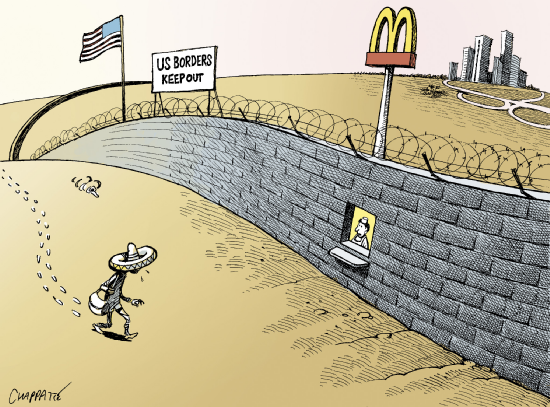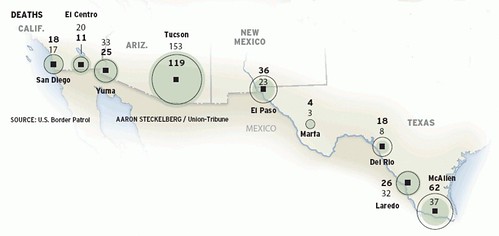TERMINALES - TOPIC 3: SPACES AND EXCHANGES
SPACES AND EXCHANGES
THE MEXICAN AMERICAN BORDER
Why do Mexican people decide to migrate to the USA?
What are the consequences of the Mexican migration?
I. Discovering the border fence.

Document 1

Document 2
|
Document 3: The US-Mexico border fence
The Security Fence Act was suggested in 2005 and passed on October 26th 2006.
The US government has authorized the construction of a 700-mile fence to prevent the illegal crossing of the US-Mexico border.
In September 2007, 70 miles of new fencing were built, doubling the length of the existing barrier.
In 2010, the fence project has been completed from San Diego, California to Yuma, Arizona
|
Document 3
Questions about the documents:
a. Introduce the three documents and say what the general topic is.
The first document is an untitled cartoon (by Chapatte), the second document is a map entitled proposed fence on the southern border and the last document is a text entitled the US Mexico border fence. The three documents deal with the Mexican American border, which consists in a fence separating Mexico from the USA.
b. Explain what the fence is (where, why…). What is the aim of this fence? (doc 2 and 3)
The fence is a 700-mile barrier that has been built all along the Mexican American frontier. The building of this fence was decided by the US government and the goal is to prevent immigrants from entering the USA illegally.
c. Concentrate on document 1: describe what you see (who, where, what…) and explain what the document wants to highlight.
This cartoon deals with the Mexican American border. The picture is divided into two parts. A wall made of brick and barbed wires is dividing the land into two parts. On the left, we can see a man walking in the sand and judging from his hat, a sombrero, we can deduce that he is Mexican. It seems that he has been walking for a long time because he is sweating. He must be exhauted, hungru and thirsty.
The country beyond the fence is the USA. We can make out skyscrapers in the background and a Mc Donald’s logo in the middle of the desert. Those two elements are symbols of the USA. Moreover, the Star-Spangled banner (the American flag) and a placard that reads US borders are placed above the fence.
In the middle of the fence, there is a custom agent at a counter. This character is problem here to check the ID’s of people who want to cross the border.
Message = Mexican people are leaving their country because they are attracted to the USA (the American dream). As too many Mexicans want to cross the border, the USA has decided to build a border with barbed wires so as to prevent illegal crossings. Moreover, it is clear that the USA are ready to sell their goods, their products (their food and drinks in this precise case with Mc Do's) to Mexican people but they do not want them to cross the frontier. The USA want to take advantage of the Mexican money without letting Mexicans crossing the border. They do not want illegal people in their country but they do accet their money.
II. Why is it an attractive border for Mexcian people?
Document 1:
|
Each year, over a million Mexicans cross the US border. Although the US authorities try to keep the Mexicans out, it is impossible to guard the 3,100 kilometer border. In addition, under the NAFTA agreement, there has been an increase in trade between the USA and Mexico.
This means that there are more vehicles crossing the border each day. Nearly 200 trucks legally cross the bridge between Juarez ( Mexico) and El Paso (USA) each day. It is impossible for customers to check them all.
About 300,000 Mexicans illegally enter the USA each year. This is largely a response to the push factors in Mexico and the perceived pull factors in the USA […] There is a considerate amount of resentment on the part of the US population.
G. Naggle, “Development and Underdevelopment”, Nelson 2004. |
Document 2:

Magnard, section européennes
Document 3:
|
The border between Mexico and the USA is the most crossed over in the world. In Mexico, one of the consequences of free trade has been the proliferation of maquiladora factories. A new cross-border region has thus appeared, called Mexamerica. Foreign investments flow essentially to Mexico City. Other emerging metropolises such as Monterey have seen their activities diversified partly thanks to the international air links with Texas. International links have increased the tourist industry on the Atlantic coast, in Merida and Cancun, creating new urban developments.
Trade liberalization has had and will continue to have a dominant effect on Mexican imports which should significantly increase. In 1989, the commercial balance showed a deficit which has been increasing each year. Mexico has also suffered from a severe lack of investment. The unemployment rate is high (30% of the labor force) and social cohesion is weak in Mexico. In Mexico’s case, NAFTA has accentuated regional differences within the country: the “rich” North has distanced itself still further from the “poor” South which is isolated from global integration.
* Maquiladora factories: Mexican assembly plants that manufacture finished goods for export to the United States. The maquiladoras are generally owned by non-Mexican corporations. They take advantage of plentiful low-cost Mexican labor, advantageous tariff regulations ‘lessened somewhat as a result of the North American Free Trade Agreement), and close proximity to U.S markets to produce such items as home appliances and automobiles.
|
Questions about the documents:
a. Why is it difficult to control immigration between Mexico and the USA? (doc 1)
b. Who owns maquiladoras factories? What do maquiladoras take advantage of? (doc 3)
c. Explain the following sentence: “This is largely a response to the push factors in Mexico and the perceived pull factors in the USA […]”. What are the push factors and the pull factors? (doc 1 and 3)
d. Describe the cross border area (doc 2 and 3)
e. How can you account for the increase in trade between the USA and Mexico? What is NAFTA? What are its consequences on the border area?
III. The tragic consequences of the fence.
Document 1:

Document 2: Oral comprehension - Illegal crossings at California Mexico border.
Document 3: Oral comprehension - Migrant families divided at Mexican border.



/image%2F0622041%2F20181127%2Fob_2a685a_uglysweaterday-400sq.jpg)
/http%3A%2F%2Fi.guim.co.uk%2Fimg%2Fstatic%2Fsys-images%2FGuardian%2FPix%2Fpictures%2F2011%2F1%2F7%2F1294410850170%2Findia-girls-khasi-matrili-006.jpg%3Fwidth%3D1200%26height%3D630%26quality%3D85%26auto%3Dformat%26fit%3Dcrop%26overlay-align%3Dbottom%2Cleft%26overlay-width%3D100p%26overlay-base64%3DL2ltZy9zdGF0aWMvb3ZlcmxheXMvdGctYWdlLTIwMTEucG5n%26enable%3Dupscale%26s%3Df8e6465c4db0bebae504ebc9ab62d865%23width%3D1200%26height%3D630)
/image%2F0622041%2F20191023%2Fob_8df75d_sheep-158247-960-720.png)
/http%3A%2F%2Fi.ytimg.com%2Fvi%2FSM8wcoceCLs%2Fhqdefault.jpg%23width%3D%26height%3D)
/fdata%2F3474636%2Favatar-blog-1132024465-tmpphpjKOSEU.png)